SHAH ALAM: REMEMBER PCU Gagah Samudera? After almost a delay of three years, work has restarted to complete the first of two RMN new training ships. The fitting out of the 75-metre ship is being carried out at the Grade One Marine Shipyard Sdn Bhd in Lumut, Perak.
Industry sources told Malaysian Defence that work on Gagah Samudera = pennant number 271 – is expected to be completed by year end and commissioning by early 2016. If indeed Gagah is commissioned in 2016, it will mean that her entry into service is delayed for almost three years. It was supposed to enter service in RMN by mid-2013.
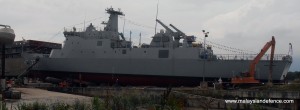
Gagah Samudera was launched on Dec 14, 2012 while her sister ship, Teguh Samudera – pennant number 272 – on Feb 27, 2013. Both were supposed to be commissioned within six months after their launch at the NGV Tech Sdn Bhd yard in Sinjangkang, Selangor.
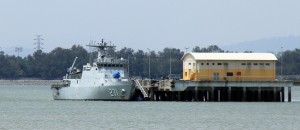
However, both ships remained incomplete and uncommissioned as NGV Tech was foreclosed by Maybank sometime in 2013. NGV Tech signed the RM294 million contract with RMN for the construction of the training vessels at LIMA 2011.
Malaysian Defence had reported late last year that efforts were underway for the Defence Ministry to take possession of both ships so work on them could be completed. However, it was delayed for some months due to legal issues.
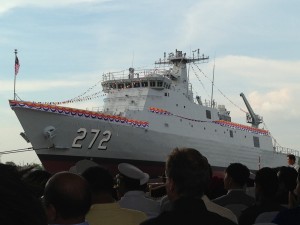
Once those were resolved both Gagah and Teguh were towed to Lumut from their berths, the RMN Hydrography Center in Port Klang and the former NGV Tech yard in Sinjankang, respectively. Gagah had been towed to Port Klang before NGV Tech was foreclosed while Teguh remained at Sinjangkang until recently.
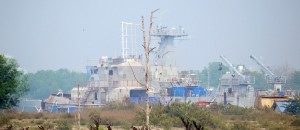
Unfortunately, Teguh will not be completed for the time being as industry sources said only Gagah had been funded for completion and commissioning. It is believed work on Teguh will only start when funds become available, hopefully once Gagah is commissioned.
Gagah Samudera/Teguh Samudera numbers:
Length 76.5 metres
Displacement 1270 ton
Crew 45
Trainees 80
Endurance 21 days
Speed 20 knots
Twin diesel engines
X-band navigation radar
S-band navigation radar
2 RHIB.
1 30mm RWS
Note. I referred this ships as PCU – Pre Commissioning Units as per the US Navy practice – as they have not been commissioned.
— Malaysian Defence
If you like this post, buy me an espresso. Paypal Payment

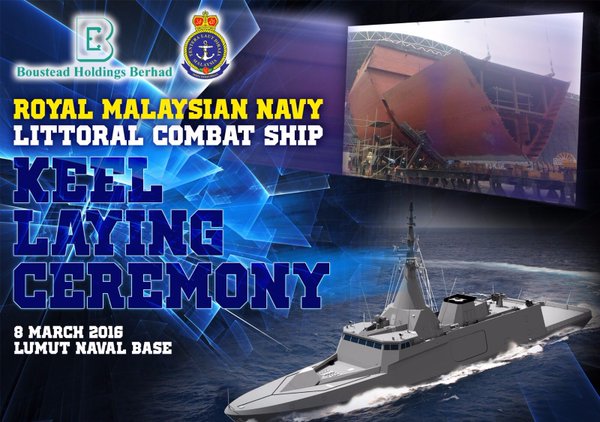
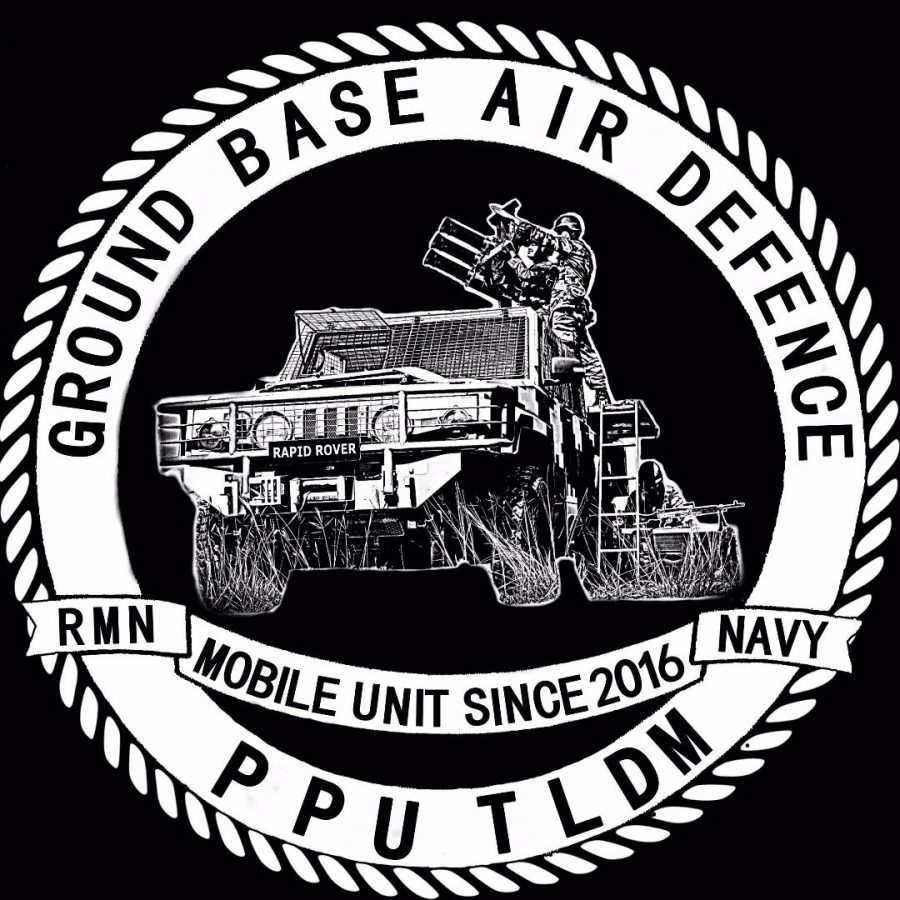

What happened to NGV tech….first job failed so what next!!
With a good management, this type of vessel should be introduce to apmm for it opv requirement. A 27 unit program is sufficient to patrol our waters
The plan is for Hang Tuah to be retired once these 2 enter service. If I’m not mistaken Samsung Thales is supplying the FCS and Kelvin Hughes the navigation suite. A school mate was intended to be the CO of one of the ships but delays in their completion led to him being given a Kedah to command.
Looks like a ship for basic seamanship trg — navigation, watchkeeping, etc, at the moment.
I was reading the linked article, Marhalim, and I agree a 76/57 mm A gun would be more useful than the 30 mm — at least for gunnery trg. I wonder if there’s a flight deck. A bit strange for a training ship to have two cranes, maybe they want to add other things later apart from RHIB, (which can use davits).
Reply
Yes there is deck space aft for helo landing up to the Super Lynx, I believed. The cranes will be used to lower the RHIBs.
Even though this is training ship, why don’t we install 70mm oto melara naval gun instead of 30mm RWS? Can this ship being upgraded to Corvette (install ASM, torpedo and SAM) since the displacement is same with the standard Corvette size. Is this ship a modular design as Kedah class?
Reply
They could have upgraded to a FAC or corvette design if they had completed the training ship on time and under budget. As it is the requirement for a 75 metre FAC remains but AFAIK not funded in RMK11.
John Rambo,
The MMEA doesn’t need 27 ships of this displacement; a few yes but not more than that. A lot of what they do and the areas they operate in require something smaller.
What went wrong with ngv tech?
Reply
I was told that they were building a ship meant for offshore support but as the customer was supposed to be under sanctions they had to find another buyer. However they failed to find a new customer for it. Because of this they failed to service their loan and the bank got the order to seize all of their assets including the two training ships.
http://www.shipspotting.com/gallery/photo.php?lid=2301133
Nice close shot of 271 last august. The ship certainly looks good. I just hope the funding is forthcoming for 272 so in end with both sisters can be operational , it can then be used for patrol duties on top of the primary training role. Will at least help to the shortage of patrol crafts
As a training vsl, IMHO vsl is good enough and I’m glad vsl will be operational soon which can put some relief on lack of hulls for normal TLDM duties . I’m not surprised when we receive news Gagah Samudera re-roled as a PV. Endurance of nearly a month, armed with a cannon (30mm is small for Position A compared to bigger DPs cannon on other TLDM vsl) and 2 type of radar band could “lured” flag country to send it to patrol duties.
http://img703.imageshack.us/img703/3900/ngvtechdsmermntrainingv.jpg
maybe it’s just me, but doesn’t the bow look a bit short compare to the 3D model image
Reply
Any CGI is not representative of the actual ship.
The decision to arm both with a 30mm may have been driven by the need to keep costs low but also because it is not intended for the ships to be in a position where they would need a larger calibre weapon.
Yes a 76mm mount would offer several advantages but the main gun is really only a self-defence weapon.
Irrespective of whether a “PV” or a “training vessel” both will perform routine patrols and also be used to train midshipmen and cadets (a role currently performed by Hang Tuah) as well as perform other roles such as SAR; as such it’s weapons and equipment fit should be seen in this context.
Hope that vsl will be on-line as scheduled.
If the navy in the future got the funding, the Samudera will a good candidate for new model of FAC. My suggestion is that the main gun should be 57mm gun, point defence 30mm gun, RAM for SAM, about 6 NSM, newest radar, newest fire control radar, avoidance & submersible detection sonar, depth charge mortar, speed 45+ knots & others. Build around 24 vessel.
@ nalzar 73
How in the world for a ship that big with all the weapons that you wanted, could you push the speed to 45+ knots?
A 57 mm main cannon, two 30mm AA cannons and 2 gpmg or hmgs would suffice for samudera type vessels if just for surface patrol work. Minimum 6 would do coz we already have the 6 opvs
How come you guys are such experts with numbers?
Do you know about ship availability and maintenance, patrol duration and distance, vessel endurance, distance from bases and pier capacity?
Kamal, the armament you cited in some ways exceeds the Kedah class and even the Lekiu frigates.
No la not an expert. Just from hearsay from some cousins in the navy and my own open source research. Opinion express here is entirely of the writer unless this forum is only for those exclusively in the armed forces or people expert in military related matters
@ am
Kamal’s opinion on the armament (1 main gun, 2rcws and 2 pintle mounts) is quite logical for an opv. Imo it is the kedah which is too lightly armed.
Unless you are confused with nalzar73’s super samudera.
…says:
The US LCS Freedoom can speed up to 40 knot + if I’m not mistaken. The samudera is half the size. Even the Arleigh Burke destroyers can speed up to 40+ knot if I’m not mistaken.
I base the fictionally armaments Samudera class FAC on the Laksmana class that we have right. I think the armaments quantity is almost the same.
The need for the 24 vessels because we have a very large area of sea to protect. Even with a speed of 45+ knots. It will take a ship few hours for example from Teluk Sepanggar to Pulau Layang2 to get there if I’m not mistaken.
The Laksamana class was intended for navies which wanted a corvette size vessel with the firepower equivalent of a frigate or corvette.
Before we go into specifics as to how replacements for the FAC fleet should be armed and what their speed should be; we should really ask what roles are they expected to perform? Then we have to ask what is the threat environment, whether spending a significant amount of the overall budget on weapons is justified in line with the threat environment, the intended roles of these ships and how they’ll tie in with the existing assets. You want faster speeds, you need more powerful engines, period, which equates to more cash. And with faster speed, we really have to ask how often will this faster speed be needed? You want more weapons, you need better sensors, which equates with more cash? All boils down to : what roles are these ships intended to perform in peacetime and in time of war… ….
All RMN ships, with the exception of Tunas Samudera, have pintle mounts for GPMGs. The Kedahs have 4: 2 for GPMGs and 2 for HMGs. You want RAM, someone can say that RAM is a point defence weapon and that it’s utility against supersonic threats is questionable. He can also say that a single launcher doesn’t provide all round defence and the 2 are needed. You want a 57mm, the salesman from Oto Melara or his private agent can point out that a 76mm can also be used for NGFS. It never ends….. Like I often say : everything is a compromise and trade offs have to be made.
Azlan
Imo the 76 mm is more suited 4 ngfs role. 57mm vs 76mm? No contest. Oto melara all the way. One goes bang while the other goes boom. Way bigger holes on the “enemy” ships to. The 57 mm is more suitable for tacking down smaller targets. Sampan or ect. Some will argue that it can be task 4 anti aircraft role too but hey that is why we have the sam and the 30mm.. i had to admit that i was a bit shocked when they chose the 57mm 4 the lcs..
The problem is when people have half a clue. Why does a Burke do 32 knots. Because this is a little bit above the 28knots a carrier battle group needs to steam at to conduct fixed wing air operations. Burkes are part of CVBGs….so 32 knots.
LCS makes 45 knots on dash because it was some bullshit some admiral made up to justify the program. It is totally useless since it would kick up a great big rooster tail and wake, making the low observability moot. It just has huge engines that are incredibly inefficient in terms of size and mass.
If you propose to control all your sea area with a checkerboard of ships…you will lose them one at a time. But you could not afford that many anyway.
Good grief……
“The US LCS Freedoom can speed up to 40 knot + if I’m not mistaken. The samudera is half the size. Even the Arleigh Burke destroyers can speed up to 40+ knot if I’m not mistaken.”
Nalzar,
Bear in mind that both the LCS class and Arleigh Burke uses jet turbine engine not CODAD. It’s more expensive to run and complicated maintenance wise. Besides, we don’t have the expertise to operate or maintain them. The US can afford gas turbines as they have a huge supply armada for extensive refuelling. The sea condition there is also harsher than ours, therefore it necessitate more powerful engine. For us, 25+ knot CODAD would suffice. Speed is good of course, but even with 45 knots it would not be enough to be “anywhere, anytime” to patrol our vast shores. It would be more ideal if all patrol vessels have the capability to launch VTOL UAV instead.
Actualky speed is not everythibg. Do uou know that the fast engines that pushes out high power n speed cannot sail for long at a slow speed?. After say every two or three hours these ships must ask for permission yo blow their stacks. N then they will get out of formation gun their engines n burnt up all the left over fuel in the engines. They must run their engines until all the black smokes comes out clear then they will ask for permission yo joun the formation n ho slow again. So speed itself is notbevetything.
Shed,
If you ask the Israelis they will say the Super Rapid – from experience in Gaza and the Lebanon – is good for NGFS but then they don’t have anything larger. Ask the RN and it will say 114mm and the USN will say 127mm but both will maintain anything smaller is a
peashooter and has no range.
The Bofors Mk2 and Mk3 are excellent for AA work; especially when firing 3P. When firing against unarmoured targets – like most ships these days – it will make a nice hole and cause damage : don’t have to sink a ship to make it not capable of combat.
Until the day comes when NGFS is a priority, when we have bigger ships and when we need to fire at battleships or cruisers; 76mm or 57mm is fine. What we have to do is decide on a single main gun calibre and stick to it rather than have 2 different calibres.
FACs are just that — fast attack craft. Their role is to attack surface or land targets. Obviously because of size, they are best suited to the littoral sea (or a narrow straits). Their advantage is significant firepower at relatively low cost. Low cost may translate to higher numbers. Small size also means they can make do with small berths and can be easily distributed along the coast. Major disadvantages include low endurance — time on station and amount of munitions — and almost no air defence capability. But they’re not intended to fight for extended periods, they’re intended to discharge their weapons and withdraw to reload. Of course, being ships they can also play other secondary roles like ISR, SF insertion, anti-piracy, even naval diplomacy, etc.
“what roles are these ships intended to perform in peacetime and in time of war”
I think it’s the other way round. In general, the main consideration in acquisition of a naval ship is its wartime role. Specifically designated training ships are the only ships whose peacetime role (training for war) comes first. For other warships, peacetime role comes second.
In our case, we have plans to replace our FACs but not with other FACs. This is unlike the TNI-AL which still sees the need for FACs.
Apart from sea keeping and endurance; another traditional weakness of FACs are their vulnerability to air power, we saw this in WW2 (MTBs and S-Boots) and in Battle of the Bubiyan Channel : the fitting of RAM on Bundesmarine FACs is intended to rectify this problem. Other problems faced include the affects of vibration on sensors (when moving at high speeds) and sensor limitations caused by a low free board.
On paper the first consideration should be a ship’s wartime role but in reality peacetime considerations factor hugely when it comes to deciding what to get. No point getting a man of war that’s perfect for high intensity ops but is not practical to be used in peacetime.
Reply
I have written before that the RMN wants boats not smaller than 75 metres which has better sea keeping qualities.
@ marhalim
Those requirement for larger ships to replace the fac was drawn before the lahad datu conflict. It was based on the tldm’s use of fac’s around the layang2 waters, which was not the shallow littoral waters where the fac is ideal. Basically they need a cheap opv with some endurance and better seakeeping to stay on station to shadow other countries coast guard and navy ships around layang2 area. That’s why they want to replace the fac’s with bigger ships.
Warships almost always can carry out maritime duties not related to war. It’s the basic platform, that of a ship, that allows this. It’s been done for centuries. The only thing they don’t do is large scale fishing. Look at the warships — LPD, aircraft carrier, frigates, corvettes — in the Mediterranean doing rescue work. It is superfluous to factor in peacetime role for warships, because warships, being ships, can innately do any peacetime mission that can be done by a civilian ship. They may need fitting out, eg Indera Sakti/Mahawangsa acting as hospital ship, but the capability is already there.
My description of FAC is how the Swedish Navy used their Spicas and FACs. In fact some of the Spicas were kept up-slip and only launched when there was a possible threat in the numerous waterways along the Swedish coast. They were amazed we kept the Handalan class in the water all the time and used it for extended patrol duties.
Ferret,
I was referring to the RMN. Yes naval ships in general can and do perform non military roles – has been the case for centuries – but in our context when deciding on what to get and how to fit it out; peacetime considerations play a huge part, more so I can argue when compared to larger navies.
……,..,
What you described is precisely why we ordered the Kedah class : as a replacement for the Vosper built PCs with a ship more suitable of patrolling the EEZ.
The main issue with our FACs is not so much their inability or limitations in operating in a non littoral environment but their sea keeping in certain Sea States and their endurance.
The need for new ships to replace the FACs are to perform roles like sea denial, escort work, routine patrols, etc, work that can be performed by a less well armed and cheaper ship compared to the Lekius and LCS.
Azlan,
I was talking about RMN except for the FAC. But notice the similarity in the deployment of the FAC?
“peacetime considerations play a huge part, ”
They’re warships! And we are talking about peacetimes ‘roles’, not ‘considerations’. Perhaps you can give examples of peacetime roles are that are considered so important, equal or more important than wartime roles, in warship acquisiton in our context.
With regard to comments by …, the point is that the 70m requirement was made before Lahad Datu. Now there may be second thoughts about FAC (if we take >70m to mean a corvette), I don’t know.
Escort work actually means gaining a measure of sea control, which, as you know, is more difficult than sea denial. I don’t think a ‘less well armed or cheaper ship’ as you say is appropriate for the task. It requires at least a corvette/frigate and armed like the Gowinds or even as large as FREMM/T26 frigate.
Again : peacetime considerations play a huge part in determining what we buy. I did not imply that major modifications would be needed for a man of war to perform peacetime roles or that a man of war’s prime function is not to engage in combat.
Escort work. First of all how many ships are to be escorted, over what distance and against what opposition? The RMN obviously can only have so many Lekius and LCS and there will be instances which don’t require a Lekiu or a LCS. Hence the need for ships which are cheaper to buy and operate and are less well armed to perform certain types of duties; the kind of duties any future corvettes will perform and duties which don’t require them to be as well armed as a Lekiu or an LCS.
The requirement for a corvette type vessel was made about 2 decades before Lahad Dato based on limitations with the Vospers and the FACs. My definition of an FAC is something in the 400-600 tonne region. Anything larger and it becomes a corvette.
Don’t confuse the vosper replacement requirements with the fac replacement. The fac replacement requirements only surfaced in the 2000’s
Then tldm thought they would relinquish all littoral and near shore activities to Mmea. That’s why they wanted bigger ships to replace the fac. Then lahad datu came about, which forces tldm to rethink its commitments to littoral and near shore areas.
Reply
Technically, all of the FACs were supposed to be replaced by the NGPV (27 vessel programme) but after the fiasco that was the Kedah class, the other 21 ship was scuttled. The Kasturi class SLEP was then mooted as some sort of a back up plan as they mooted the SGPV. The plan was still for RMN to withdraw from the littoral as these will be taken up by the MMEA. Lahad Datu only revealed that MMEA was not up to the job mostly because it was underfunded. As a result of Lahad Datu, the Marine police which was then supposed to roll back its forces was again given the task to control the sea border up to five kilometres from the coast. As MMEA is only getting six new patrol boats in the foreseeable future, the Navy plans remained at a stand still apart from the LCS which despite all the talk remained under threat from a budget under pressure.
……..,
I’m not confused at all.
Had 27 NGOPVs been ordered – as was planned – the FACs would have been replaced together with the Vospers. Plans were first made to replace them in the 1990’s, not the 2000’s, followed by a plan to upgrade with them with, amongst other things, a water jet and new missiles. The RMN was looking at an FAC replacement not because of the MMEA or plans to relinquish roles to them but for other reasons.
Water under the bridge but in a perfect world Amin Shah wouldn’t have buggered up the NGOPV programme and 27 ships or even less, would have been delivered. We would have had a long term relationship with a foreign yard, would have been able to progressively upgrade subsequent batches of the Kedah class based on a common design and the amount of local content would have been progressively increased.
This would have benefited the Naval Dockyard and other local companies, the RMN and the taxpayer.
Hello…NATIONAL INTEREST LA!
But in a hindsight, if the ngpv programme was successful, tldm might not get their 6 asw frigates currently disguised as a “sgpv/lcs” programme.
In all purposes, the gowinds is a frigate (in the classical term) and imo should not be seen as an extension of the kedah class opv. They should be named after legendary warriors, not states.
27 NGPV better than 6+6.
……,
Had we stayed the course with the German Naval Group, we could have built subsequent batches based on a common design (the MEKO-A100) to perform various roles to replace both the Vospers and the FACs.
In due course we could have gone for a larger Meko to do what we now intend to do with the Gowinds. The German Naval Group (Thyssen replaced HDW as the main player) submitted an design for the LCS programme bit things had gone so sour and the French had such strong backing that the Germans never stood a chance.
The idea behind the NGOPV programme was sound, its execution was bugger all. The local industry didn’t benefit and the taxpayer and RMN got screwed.
Damn that Amin Shah fellow. If wasnt 4 him the RMN would have been a major naval power in the SEA. The Indonesian wouldnt dare to lift a finger on the ambalat issue. BTW i still consider that any future conflict will involve the Indonesian…
fire on board the engine room of teguh samudera, definitely not a good record for the g1 shipyard
http://www.sinarharian.com.my/semasa/kapal-latihan-tentera-laut-nyaris-terbakar-1.474026